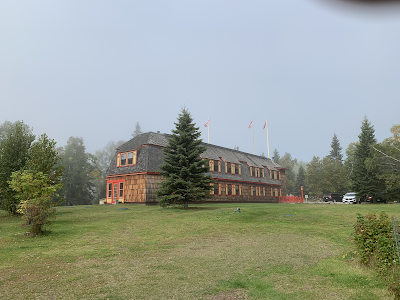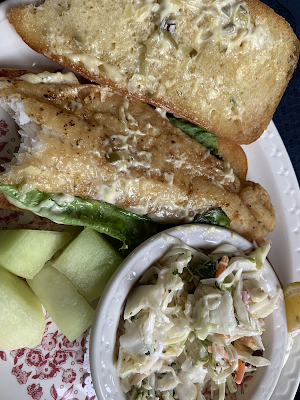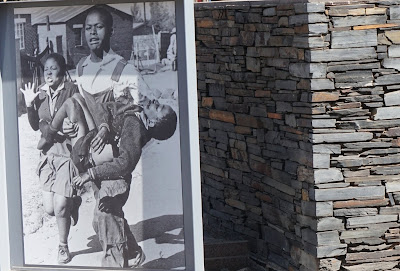We are focusing this blog on our travels. We have the opportunity to take long road trips and will chronicle these trips and offer educational content when feasible. Additional content created by Mark Grabe can be found at http://learningaloud.com
Tuesday, September 17, 2019
Naniboujou
Sleeping Giant Provincial Park
Friday, September 13, 2019
Canada, eh
Thursday, September 12, 2019
Sault Sainte Marie
I knew the name of our present location, but I had no idea how it was spelled. I tried Sioux Saint Marie. The search engines figured out what I mean, but I was surprised to learn it was Sault Sainte Marie. I guess the translation is basically "the rapids of the Saint Mary's River". The important word for present day use of the Great Lakes is rapids. The giant ships that move from one lake to another could not do this if there was not a way around the rapids. The engineering answer to allow transport was a canal with locks. Today we watched a large ship carrying iron ore pass through the locks.
The ship we watched move through the lock was 1000 feet long. The locks lowered this ship 21 feet before it would be at the level necessary to enter the water outside the locks.
Wednesday, September 11, 2019
My pasty post
Today I did run across an old friend - the pasty. I have also seen it spelled pastie, but I was careful to identify what we ate today as a pasty. The pronunciation is past ee and not paste ee. To me, it seems like a chicken pot pie (if you get the chicken pasty) with a little different shape. These must be shaped and then baked without a pie tin. When you drive down the road here it is not difficult to find a little shop that serves these goodies. The density of restaurants with this offering within this narrow band of the country is interesting. This is not a fine dining item. We noticed workers stopping by for several that they took away in a bag and headed off in their pickups.
Leaves, light houses, but no cell towers
Monday, September 9, 2019
Circle Route
Our first stop was in Bayfield, WI. This lake side town is about 100 miles from our lake place in Minnesota. We have visited before and had to stop at a local eatery for their great pickled herring and a beer. This is not the pickled herring you would get in a grocery and is prepared locally.
Thursday, September 5, 2019
The lingering legacy of Soweto
Elephants
Our friend Stan predicted that our most amazing memory would be the first time we saw elephants. While the elephants were certainly amazing, my favorite memory was when we spotted a couple of painted dogs (wild dogs). We later realized the dogs were more numerous than we recognized and they were stalking a group of impala that explode into flight when the dogs moved in initially running right at us. I have photos of some of the dogs, but not the moment they attacked the impala.
The elephants were amazing. Here are a few photos. We saw many elephants - from the air when we took a helicopter flight over Victoria Falls, from boats as we cruised the Zambezi, and on several jeep drives. I will include a sample of images below and conclude with a short video as they picked up speed descending toward the river to drink.
Monday, September 2, 2019
Personal sacrifice and commitment to a higher cause
Sunday, September 1, 2019
Unique experiences
Saturday, August 31, 2019
Twitchers
I was never a bird watcher. I have friends who watch birds and I have even accompanied them on outings. They seem like nice people with a strange hobby. They keep lists and trade numbers reflecting their accomplishments. I wonder if they cheat like golfers. I take pictures. You know I saw something if I can show you the pictures. I saw this elephant. I saw this leopard. I tried this with birds, but that little smudge in that bush could be about anything. You can’t see that it has three red spots on the crest of its head and a downward curving bill.
I do try to weave in some tech content with my travels stories. In this case, the title of this content might be described as "there is an app for that". There are plenty of great apps for bird identification and related activities. As I have questioned my fellow travelers regarding their bird watching activities, they often are using an app on their phones not only to identify the birds, but also to keep a running list of their finds. The app makes these tasks fairly easy. See something, match what you see with a bird pic within the app, and click on the appropriate button to date, locate, and store the find to your list. I found what they were using and it cost $33. This would have probably been the most expensive app I had purchased had I made the purchase. I do sometimes spend more when one considers the cost of a subscription fee, but this was the cost for the African edition of the birding app.
My alternative was to take advantage of the "lens" feature of Google photos. Google will take a stab at identifying any bird I photograph. Actually, it will take a stab at attempting to identify anything. Google will offer me alternatives which is a great opportunity for me to consider whether I agree with the suggestion Google makes and it will find online content related to what it thinks the photo is. Often the suggestion is to a Wikipedia entry. I tried this with several birds and Google seems to have been accurate in all cases. At least what Google suggested was something I knew we had seen and was appropriate to the area in which I had been when photographing the bird.
Here are some examples using screen captures to show my photo (at the top) and the Google suggestion below.
Friday, August 30, 2019
Climate change
Thursday, August 29, 2019
Tiger Fish from the Zambezi
So, this is a two-step process. First, catch smaller fish that can be used for bait. Cut up the smaller fish and drift waiting for a Tiger will strike. Wait for line to be taken, close the bail, and then set the hook. Hold on
Wednesday, August 28, 2019
Bugs
So, here is the word on the bugs. If you are concerned about the number of bugs and say have experienced Alaska or northern Minnesota or Wisconsin, there is no comparison. It is torture in the evening to walk from the dock to our northern Wisconsin cabin in the summer because of the mosquitos. The ticks are also gross and have sent us to the clinic for shots a couple of times [I had one attach between my toes once when I was wearing sandals. Thinking I must have athletes foot because I am such an athlete, I did not seek medical attention until I started to notice red streaks up my ankle and calf. Not even a test for Lyme disease - immediate antibiotics.]
However, the consequences of exposure to mosquitos and tsetse flies in Africa can be damaging. The mosquitos are mainly known for malaria and the tsetse flies for sleeping sickness. We are taking medication for malaria. We did mostly invest in khaki-colored clothing to avoid tsetse flies.
In summary, the insect density at this time has been low. It still pays to take precautions.

















































